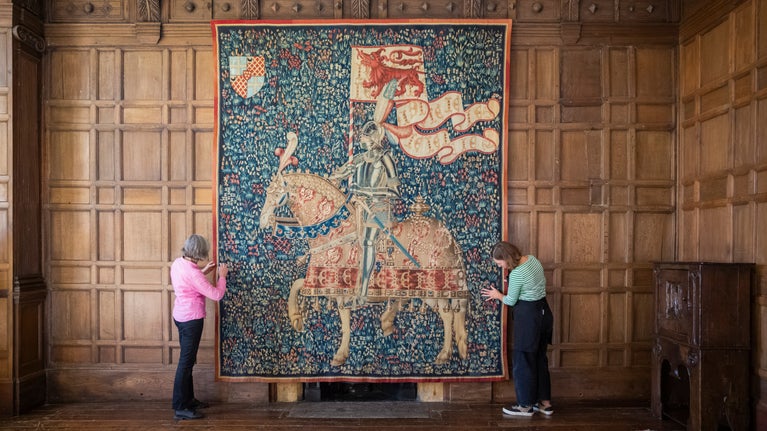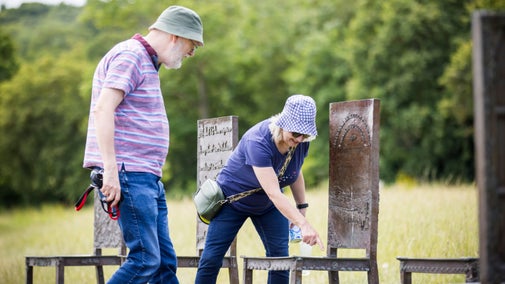
Preserving the past
From conserving historic works of art and delving into archaeology to supporting urban heritage and parks, find out about our vital conservation work.

Rowena Willard-Wright and artist Hew Locke talk in detail about each chair in The Jurors. Expand each image to help identify each chair and artwork on each side.

Hew Locke describes his classroom scene, inspired by the United Nations Convention on the Rights of the Child

Hear suffragette Lillie Lenton talk about her famous escapes.

Oscar Wilde’s Ballad of Reading Gaol, published while he was in exile in France, with a specially recorded reading by Simon Armitage.

Hew Locke talks about the 1989 oil spillage in the Gulf of Alaska when the Exxon Valdez tanker ran aground.

An introduction to Cornelia Sorabji, the first woman to practise law in India.

Hew Locke talks about his vision of the Magna Carta and its principle of trial by jury.

Hew Locke talks about this Amerindian headdress and the ideas that it invokes.

Hew Locke and Curator Rowena Willard-Wright tell us about the extraordinary march of blind trade unionists in 1920.

Curator Rowena Willard-Wright and Hew Locke describe the imagery on this chair that refers to serfdom, activism and resistance in Russia.

Hew Locke talks about Phillis Wheatley, the first published African-American woman and Mary Prince, the first woman to present an anti-slavery petition to the British parliament and the first black woman to write and publish an autobiography.

Hew Locke talks about Harvey Milk, gay rights campaigner and first openly gay person to be elected to public office in California.

A description of the portable charkha, or hand spinning wheel for cotton, designed by Mahatma Gandhi and used as a political symbol of resistance to British rule.

Hew Locke tells us why he has included the image of a shredder – representing the destruction or ‘redaction’ of evidence.

Hew Locke tells us about Nelson Mandela's prison cell, where he served 18 years of his life sentence.

Hew Locke explains what his imaginary ‘disappeared’ faces represent, and Curator Rowena Willard-Wright tells us about the Victorian language of flowers.

Hew Locke talks about Speaker’s Corner and Sir Tim Berners-Lee, inventor of the world wide web, who called for an online Magna Carta.

Hew Locke tells us why this image depicts sea vessels and what they represent.

Hew Locke introduces us to 'The Golden Rule' that states you should treat others as you would wish to be treated yourself.

An explanation of the use of the hollow boab tree, found in Australia, and their use as prisons.

Hew Locke introduces us to the Confucian principles of Ren (humaneness), Li (ritual) and Yi (justice).

Hew Locke talks about the ship Zong, from which 133 slaves were thrown overboard in 1781.

A description of the Ancient Egyptian scales topped with the head of Ma'at, the goddess of truth, justice and balance.

Hew Locke introduces us to Xiezhi, a legendary creature and symbol of justice and law in Chinese mythology.


From conserving historic works of art and delving into archaeology to supporting urban heritage and parks, find out about our vital conservation work.
Learn about the historic sealing of the Magna Carta, a medieval priory, an ancient tree where Henry VIII wooed Anne Boleyn – and the site of a 1930s nightclub.

Twelve intricately carved bronze chairs celebrate the endurance of Magna Carta at Runnymede. Discover the artwork and its inspiration here.

Reflect upon the history of Runnymede inside this immersive architectural installation, which celebrates the sealing of Magna Carta at Runnymede over 800 years ago.

Runnymede and Ankerwycke is a three pawprint rated place. Enjoy riverside walks and open countryside on a dog walk at Runnymede and Ankerwycke. Find out where dogs can explore and read the Canine Code.
